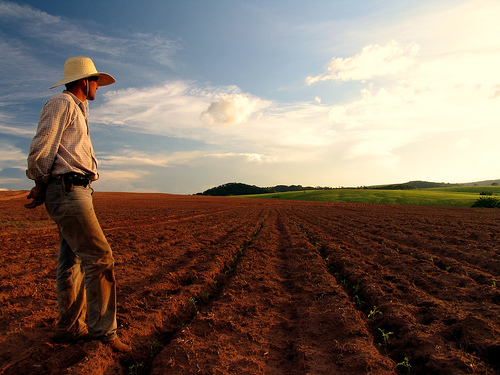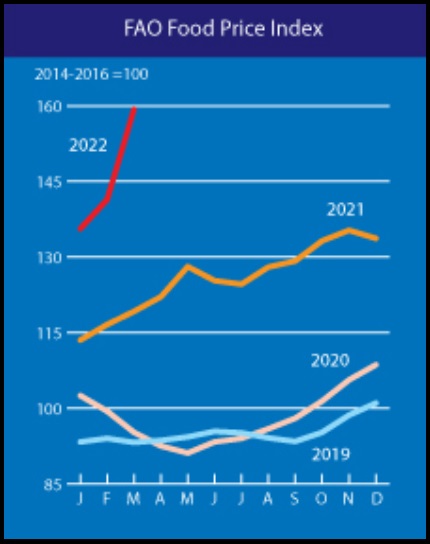The UN Food and Agriculture Organization reported on Friday they are recording the highest Food Price Index since they started recording thirty years ago. With record highs in prices for cereals, vegetable oils, dairy and meats
This issue has been a slow burning fuse toward the biggest powder keg in modern history, and it is about to get very serious. We have been warning about it since last fall {Go Deep}. In the most deliberate and painstaking ways possible, we have been urging everyone to take this issue seriously.
The background cause is complex and started with the 2020 government response to the pandemic. U.S. and international government intervention in the food supply process has been FUBAR from the beginning. Every action taken since early 2020 has been one bad policy after another; building failure upon failure, crisis upon crisis, bad decision upon bad decision, bringing us to a precipice summed up by saying “the absence of food will change things.”

Some will say the food prices we are about to experience –and the crisis it will create– was deliberate. Others will say this was the cumulative outcome of major failures on the part of the government. At this point the former makes more sense, and the latter looks like a justification and excuse, because if government entities were really serious about food prices and shortages, they would be taking pragmatic steps to mitigate the problem; they are not.
There are simple things government could do, such as helping farmers offset targeted fertilizer costs, providing relief for diesel fuel and energy costs, and taking other simple steps that would help the agricultural industry.
Instead of responding with the urgency this would demand, the collective government action has been to ignore the problem (talk soundbites), and give speeches about using subsidies to offset the end result (consumers) – without ever addressing the root cause. All this while fueling conflict in Ukraine and chasing radical energy policies under the guise of global climate change.
The UN Food and Agriculture Organization (UNFAO) keeps track of food prices and projections using a global index [SEE HERE]. What they are calculating, and what they are projecting based on the current calculations, is a major increase in food prices combined with a major increase in food scarcity due to the unaffordability of food products.
 The baseline of 100 is the monthly rate of change for a basket of food products using the period from 2014 to 2016.
The baseline of 100 is the monthly rate of change for a basket of food products using the period from 2014 to 2016.
The current rate of change is indexing at 159.3, meaning the monthly increases in price are almost 60% higher than the base period. Trying to chart this rate of index is almost impossible, as it seems literally exponential. (red line in graphic)
In 2020, the monthly rate of change increased to an index of around 110. In 2021, the monthly rate of increase went from 110 to around 135. In the first three months of 2022, the index has jumped from 135 to almost 160 (in three months), and there is no end in sight.
The FAO Food Price Index* (FFPI) averaged 159.3 points in March 2022, up 17.9 points (12.6 percent) from February, making a giant leap to a new highest level since its inception in 1990. The latest increase reflects new all-time highs for vegetable oils, cereals and meat sub-indices, while those of sugar and dairy products also rose significantly.
The FAO Cereal Price Index averaged 170.1 points in March, up 24.9 points (17.1 percent) from February, marking its highest level on record since 1990. This month’s increase reflected a surge in world prices of wheat and coarse grains, largely driven by conflict-related export disruptions from Ukraine and, to a lesser extent, the Russian Federation. The expected loss of exports from the Black Sea region exacerbated the already tight global availability of wheat. With concerns over crop conditions in the United States of America (USA) also adding support, world wheat prices rose sharply in March, soaring by 19.7 percent.
The FAO Vegetable Oil Price Index averaged 248.6 points in March, up 46.9 points (23.2 percent) from February and hitting a new record high. The sharp rise of the index was driven by higher sunflower, palm, soy and rapeseed oil prices.
The FAO Dairy Price Index averaged 145.2 points in March, up 3.7 points (2.6 percent) from February, marking the seventh consecutive monthly increase and lifting the index 27.7 points (23.6 percent) above its value a year ago. The upward trend of dairy product prices persisted, mainly supported by the tightening of global markets due to inadequate milk output in Western Europe and Oceania to meet global demand. Quotations for butter and milk powders rose steeply.
The FAO Meat Price Index* averaged 120.0 points in March, up 5.5 points (4.8 percent) from February, also reaching an all-time high. In March, pig meat prices registered the steepest monthly increase on record since 1995.
The FAO Sugar Price Index averaged 117.9 points in March, up 7.4 points (6.7 percent) from February, reversing most of the previous three months’ decline and reaching levels more than 20 percent above those registered in the corresponding month last year. [DETAILS]
In the United States and North America as a whole we are blessed and fortunate. We have abundant, healthy and fertile land that allows us to grow more food than we consume. We are a net exporter of food products. However, while we do not have to worry about shortages at the scale of other nations, there will be scarcity.
Additionally, the price increases will hit the U.S. consumer at a lesser, yet still big time significant, scale. The issue in the U.S. will be food insecurity due to massive increases in price. The middle class will spend more of their earnings and wages on food, and people will literally make changes to their food purchases based on these massive increases in price.
In food dependent nations, the scale of the issue will be far greater. In part, this is the reason the southern border crisis will be much more severe this year. We will see an influx of migration due to food availability and unaffordability issues, that is certain; however, that issue is also incidental to the massive influx that is going to happen as a result of the Biden open-border policy.
In the strongly food dependent nations, the food price and scarcity issue has already triggered panic.
We are several generations separated from any time in history where people have worried about the United States having abundant affordable food. Arguably, those under 40 to 45-years of age do not have any reference to the type of food scarcity and food inflation that is coming.
As we have mentioned for quite some time, “the absence of food will change things.”
We are in an abusive relationship with government leaders.
